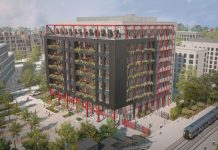Bristol has been revealed as the UK’s most resilient major regional city for commercial property transactions over the past decade – and the head of the Bristol office of leading real estate company Colliers International is predicting the next decade will be even more impressive.
Analysis of take-up data from Radius Data Exchange by EG, has shown Bristol to have been the most consistent major regional city for real estate transactions since 2008, recording the smallest difference between its least active year in 2009 which saw 830,949 sq ft take-up, and its average of 1.1 million sq ft.
Tim Davies, head of South West and Wales for global real estate advisor Colliers International, who has worked in commercial property in the Bristol area for some three decades, said: “This finding about the strength of commercial property in Bristol confirms the sentiment of those of us familiar with the market.
“Bristol benefits from having what the UK chief economist at Colliers International recently identified as a ‘real economy’, which judging by this analysis helped to reduce the effects of the global recession in 2009 upon commercial property in the city.
“This ‘real economy’ results from Bristol having an impressive balance of professionals in sectors including Technology Media & Telecommunications (TMT), financial, engineering and scientific, and it has been anticipated that this will help insulate the city from any major Brexit impact.
“The next decade should see an even more impressive performance from the commercial property market in Bristol, as the city is set to become more accessible as a result of two major infrastructure changes that have the potential to unlock thousands of new jobs directly and indirectly.
“Construction of a new M49 junction is presently underway to the west of Bristol, and will open up 300 acres of employment land at the strategically-significant Avonmouth Severnside Enterprise Area, which is the largest brownfield development site in Western Europe.
“Further employment land will be opened up to the east of the city with the construction of a new M4 junction 18a near Emersons Green. The cabinet of South Gloucestershire council last month decided to recommend the western option for this junction, bringing closer to realisation the opening up of 112 acres of development land which is expected to create 5,700 jobs and generate £449 million for the economy.
“The new M49 and M4 junctions will combine to make Bristol even more attractive to investors and to occupiers, and will be a powerful catalyst for growth of the city’s economy and its commercial property sector.”
EG’s analysis of take-up data over the past decade showed that among the six cities that have averaged an annual take-up of at least one million sq ft, Bristol recorded the smallest percentage difference between its least active year in 2009, during the recession, and its average annual figures.
Activity in Bristol dipped by 26.2% between its least active year in 2009, when take-up was 830,949 sq ft and its annual average of 1.1million sq ft. By contrast, there was a 39.3% difference between the least active year in Leeds in 2010 at and its average of 1.2m sq ft, while in Manchester the difference was 36.4%.
Mr Davies added that the findings of the EG analysis served to underline Bristol’s recent ranking for the first time in the Top 20 of the European Cities of Influence index from Colliers International, which placed it in 12th position alongside leading cities including Paris, Madrid, Dublin, Zurich, Warsaw, and Edinburgh, and in second place overall in the Small Cities sub-category.
He said: “It is of particular note that Bristol had the highest quality of life score of all the English cities in the Cities of Influence report, which reviews and ranks 50 European cities as destinations for investment capital, based on their occupier attractiveness, availability of talent, and quality of life factors alongside economic output and productivity.
“An attractive city attracts people to live and work in it. Recent figures have shown that more than 80 people a week are moving to Bristol from London, and this will help the local economy to expand and diversify, which in turn will result in higher levels of real estate investment.”



















